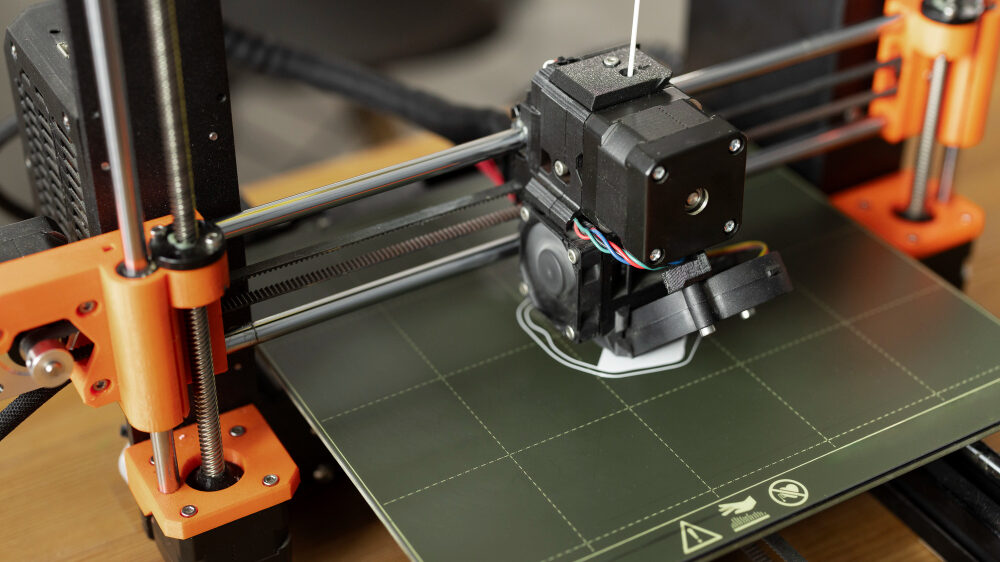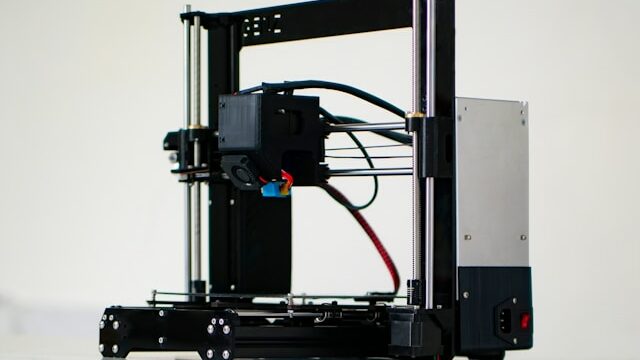Are you wondering about rapid 3D printing and its production capacity? At Imprimy, we are here to provide you with all the answers you are looking for.
Rapid 3D printing allows for accelerated manufacturing of prototypes and complex parts thanks to advanced technologies that significantly reduce production times.

What is rapid 3D printing?
Rapid 3D printing is an additive manufacturing method that quickly creates physical objects layer by layer from a digital model, allowing to prototype and produce functional parts in a reduced time.
- What is rapid 3D printing?
- What are the fastest 3D printing technologies?
- What are the advantages and benefits of rapid 3D printing?
- What are the concrete applications of rapid 3D printing?
- What are the limits and challenges of rapid 3D printing?
- What Could Be the Future of Rapid 3D Printing?
- Conclusion: Rapid 3D Printing
Overview of Rapid 3D Printing
Rapid 3D printing, also called rapid prototyping, is an additive manufacturing technology that allows the fast creation of three-dimensional physical objects from digital models. It works by depositing material layer by layer (often plastic, but also metal or resin) to form the final part.
This method is widely used in the fields of research, industrial design, aeronautics, automotive, and medicine, as it enables a significant reduction in production times, advanced customization of objects, and a decrease in prototyping costs.
Speed Criteria of 3D Printing
The speed criteria of 3D printing depend on several key factors. First, the type of technology used (such as FDM, stereolithography, or laser sintering) directly influences the execution speed.
Next, the layer height determines the print resolution: the finer it is, the slower the printing. The complexity of the 3D model also plays an important role, as complex shapes require more processing time. The volume of the part, as well as the internal filling (dense or hollow), also impact the manufacturing duration.
Finally, the printer power and the print head movement speed are technical elements crucial to ensure fast production without compromising quality.
What are the fastest 3D printing technologies?
The fastest 3D printing technologies include stereolithography (SLA), selective laser sintering (SLS), and optimized fused deposition modeling (FDM), as well as Continuous Liquid Interface Production (CLIP), which speeds up manufacturing through a continuous process.
Optimized FDM/FFF
Optimized FDM for rapid 3D printing relies on several technical and strategic improvements aimed at reducing production times while maintaining good print quality. This technology, which deposits melted filament layer by layer, can be accelerated by using larger diameter nozzles, allowing more material deposition in a single pass, as well as high printing speeds made possible by robust and well-calibrated printers.
Optimization of slicing parameters (such as layer height, infill density, and movement speeds) is also crucial.
Additionally, the use of materials adapted for rapid printing, like certain modified PLA or composites, helps reduce the risk of warping while speeding up the process. By combining these factors, FDM/FFF becomes a particularly effective solution for rapid prototyping and small batch production.
Next-Generation SLA/DLP
The next-generation SLA/DLP represents a major evolution of photopolymerization technologies used in resin 3D printing, combining extreme precision with increased printing speed. SLA uses a laser to solidify the resin point by point, while DLP (Digital Light Processing) projects images of the entire layer at once, enabling faster printing.
Recent versions incorporate more powerful light sources, 4K or 8K screens for better resolution, as well as fast lifting mechanisms and accelerated curing resins. These innovations significantly reduce manufacturing times while offering exceptional detail, ideal for industries such as jewelry, dental medicine, and industrial microcomponents.
CLIP and HARP
CLIP and HARP (High-Area Rapid Printing) are two next-generation resin 3D printing technologies designed to combine high speed, large scale, and high quality.
CLIP is based on a continuous light projection through an oxygen-controlled polymerization zone, allowing uninterrupted layer-by-layer printing, much faster than traditional methods, producing parts with homogeneous mechanical properties.
HARP, on the other hand, uses a UV light source and a liquid cooling system to rapidly solidify large resin surfaces while preventing overheating, making it suitable for mass production of large parts.
These two technologies represent a major advance toward fast industrial 3D printing, combining precision, speed, and material strength, paving the way for large-scale digital manufacturing.
What are the advantages and benefits of rapid 3D printing?
Rapid 3D printing offers advantages such as reduction of production times, design flexibility, lower prototyping costs, and enables customized manufacturing with a significant time savings.
Drastic Reduction of Prototyping Time
The drastic reduction of prototyping time is one of the main advantages offered by rapid 3D printing, allowing to go from an idea to a functional physical object in a few hours or days, compared to several weeks with traditional methods.
Thanks to technologies like FDM, SLA/DLP, CLIP, or HARP, companies can perform successive iterations very quickly, correct design errors in the early stages, and validate concepts without relying on costly molds or long processes.
This speed fosters accelerated innovation, reduces development costs, and shortens time-to-market cycles, which is crucial in sectors like automotive, aeronautics, healthcare, and consumer products. By transforming prototyping into an agile, flexible, and instantaneous phase, 3D printing plays a central role in modern design.
Acceleration of Time-to-Market
The acceleration of time-to-market thanks to rapid 3D printing is a major strategic lever for companies seeking to remain competitive in constantly evolving markets. By enabling the quick creation of functional prototypes, accelerated design validation, and direct manufacturing of final parts, 3D printing significantly reduces the time between the initial idea and product commercialization.
Advanced technologies like CLIP, HARP, or optimized FDM eliminate long and costly steps such as mold making or multiple subcontracting. This increased responsiveness not only allows companies to react faster to market demands but also to adapt products more quickly based on customer feedback.
Cost Reduction in Some Cases
The cost reduction in some cases thanks to rapid 3D printing is explained by the elimination or simplification of many traditional manufacturing steps. By removing the need to produce expensive molds, especially for small batches or prototypes, it allows for substantial savings on tooling costs.
Additionally, additive manufacturing uses only the necessary material, thus limiting material waste, particularly for complex parts that are difficult to produce by machining. Companies also benefit from reduced lead times, which translates into lower development, storage, and logistics costs, thanks to more local and on-demand production.
However, this cost reduction is particularly notable in specific contexts such as rapid prototyping, customization, or low-volume production, while for large series, traditional methods often remain more economical.
Greater Flexibility for Design Iterations
Rapid 3D printing offers greater flexibility for design iterations, allowing designers and engineers to modify, test, and improve a product in reduced time and at lower costs.
Unlike traditional methods requiring fixed tooling, it enables the quick generation of modified prototypes directly from digital files, without delays related to mold or intermediate part manufacturing. This ability to instantly produce even complex design variants facilitates an agile development approach, with rapid feedback and frequent adjustments.
It encourages creative experimentation, improves the final product quality, and significantly reduces the risk of errors during the design phase. Thanks to this flexibility, development teams gain in responsiveness and efficiency, which is essential to innovate quickly and meet market expectations.
What are the concrete applications of rapid 3D printing?
Rapid 3D printing is concretely used in industrial prototyping, custom part manufacturing, the medical field (such as prostheses and implants), aeronautics, automotive, and the creation of rapid molds and tooling.
Rapid 3D Printing in Industrial Sectors
Rapid 3D printing is increasingly adopted in many industrial sectors thanks to its ability to accelerate production, reduce costs, and offer great design flexibility.
- In the automotive industry, it allows the manufacturing of functional prototypes and custom parts, facilitating testing and design optimization.
- In aeronautics, this technology is used to produce lightweight and complex components, helping to improve performance and reduce fuel consumption.
- The healthcare sector particularly benefits from rapid 3D printing to create custom prostheses, personalized implants, and precise anatomical models for surgery.
- The electronics industry also uses this technology for rapid prototyping of circuits and enclosures, while manufacturing relies on it for making molds, jigs, or replacement parts.
Rapid 3D Printing for Startups and Product Design
Rapid 3D printing is a major asset for startups and product design, as it allows the quick transformation of ideas into tangible prototypes without heavy initial investment. For startups, this technology offers exceptional agility by facilitating early user testing, frequent iterations, and rapid concept validation, which speeds up decision-making and reduces financial risks.
On the product design side, rapid 3D printing encourages creativity and experimentation, offering the possibility to create complex and customized shapes that are difficult to produce with traditional methods. It also enables on-demand production, ideal for small batches or unique items, while reducing costs and lead times.
What are the limits and challenges of rapid 3D printing?
The limits and challenges of rapid 3D printing include sometimes insufficient surface quality, material constraints, high costs of advanced machines, limited printable part size, and post-production time.
Balancing Speed and Quality
Balancing speed and quality in rapid 3D printing means finding the optimal trade-off between production speed and the precision of details or mechanical strength of the manufactured parts.
Speeding up printing, for example by increasing the layer height or deposition speed, can significantly reduce time but risks lowering surface finish quality and the resolution of complex shapes. Conversely, prioritizing high quality with thin layers and slow speeds ensures better dimensional accuracy and a more refined finish, but increases production times.
Technologies like optimized FDM, next-generation SLA/DLP, or CLIP often offer configurable settings that allow adapting this trade-off based on project needs—whether for a quick prototype to test or a final part requiring a high level of detail. This careful management between speed and quality is essential to maximize efficiency while meeting the specific requirements of the product or industrial sector.
The Cost of High-Performance Machines and Materials
The cost of high-performance machines and materials in rapid 3D printing represents a significant investment that can vary greatly depending on the technology and quality desired. High-end printers, such as those using next-generation SLA/DLP, CLIP, or HARP, are expensive due to their precision, speed, and ability to produce parts with advanced mechanical properties.
Similarly, specialized materials—such as technical resins, composite filaments, or high-performance polymers—are often more costly than standard materials, but they provide greater strength, detail resolution, and durability for printed parts. However, this investment is often justified by the reduction of indirect costs related to lead times, iterative prototyping, and customization.
For small businesses or projects, more affordable options do exist, but selecting high-performance machines and materials remains crucial to meet the quality and speed objectives required in competitive industrial sectors.
The Complexity of Settings and the Need for Expertise
The complexity of settings and the need for expertise are major challenges in using rapid 3D printing, especially with advanced technologies like SLA/DLP, CLIP, or optimized FDM. To achieve optimal results, it’s necessary to master a variety of technical parameters such as printing speed, temperature, layer height, infill, and the specific properties of the materials used.
Additionally, each machine may require precise calibration, regular maintenance, and careful handling of digital files (3D models, slicing). This complexity often means needing qualified personnel who can adjust settings according to quality, durability, and speed goals, while also anticipating potential defects or print failures.
Long-Term Reliability of Rapidly Produced Parts
The long-term reliability of parts produced quickly through 3D printing largely depends on the material choice, the technology used, and the print settings quality.
While fast production can sometimes lead to compromises in density or surface finish, advanced technologies like CLIP, HARP, or next-generation SLA/DLP can deliver parts with uniform mechanical properties and durable strength comparable to traditional methods.
However, some parts printed with rapid FDM may exhibit structural weaknesses or premature wear if the parameters are not properly optimized. Post-processing (such as UV curing, polishing, or impregnation) also plays a key role in improving the stability and longevity of printed components.
What Could Be the Future of Rapid 3D Printing?
The future of rapid 3D printing promises increased integration into industrial production, more innovative and high-performance materials, improved printing speed, and advanced automation to meet the needs of customized mass manufacturing.
Expected Improvements Between 2025 and 2030
Between 2025 and 2030, expected improvements in rapid 3D printing will focus mainly on faster printing speeds, increased precision, and a wider range of high-performance materials. Technological advances will aim to further reduce cycle times through more intelligent systems, integrating artificial intelligence to automatically optimize settings and anticipate defects.
We may also see better integration of hybrid processes, combining additive and subtractive manufacturing to improve the finish and reliability of parts. Innovative materials, including fiber-reinforced composites, multifunctional resins, and recyclable polymers, will offer new possibilities in terms of strength, durability, and environmental sustainability.
Finally, the democratization of high-performance machines at more affordable costs will enable broader adoption across industrial sectors, accelerating the digital transformation of manufacturing and strengthening global competitiveness.
Rapid On-Demand 3D Printing for Everyone
Rapid 3D printing on demand is revolutionizing access to manufacturing by enabling a wide range of users—from individuals and startups to SMEs and large enterprises—to quickly produce customized objects without investing in expensive equipment. Thanks to online services, cloud platforms, and increasingly powerful home 3D printers, it is now possible to order or produce made-to-measure parts within just a few hours or days.
This democratization encourages collaborative creation, reduces inventory through on-demand production, and paves the way for more responsible local manufacturing. Additionally, the simplification of design software and user interfaces makes the technology accessible even to beginners, while still maintaining high levels of quality and speed.
Artificial intelligence and production flow automation in support of rapid 3D printing
Artificial intelligence (AI) and the automation of production flows play a key role in the evolution of rapid 3D printing, by optimizing every stage of the process to enhance the speed, quality, and reliability of manufactured parts. AI enables the automatic analysis of 3D models, the real-time optimization of printing parameters (such as speed, temperature, or infill), and the prediction of potential defects, thereby reducing errors and waste.
Moreover, integrated automation of production chains connects printers to intelligent management systems that coordinate file preparation, quality control, post-processing, and logistics, ensuring a continuous and efficient flow. These advances reduce the need for human intervention, accelerate time-to-market, and open rapid 3D printing to more massive and standardized industrial production.
By combining AI and automation, 3D printing becomes a powerful tool for intelligent additive manufacturing, capable of meeting the growing demands for agility, customization, and performance in modern industries.
Conclusion: Rapid 3D Printing
Rapid 3D printing is now emerging as a major technological revolution that is profoundly transforming design, prototyping, and manufacturing processes across many industrial sectors. By offering a significant reduction in lead times, unprecedented flexibility for design iterations, and enhanced customization, it enables companies and innovators to gain in agility and competitiveness.
Despite certain challenges related to costs, the complexity of settings, and the need for technical expertise, ongoing advancements in technologies such as optimized FDM, next-generation SLA/DLP, CLIP, and HARP, along with the growing integration of artificial intelligence and automation, promise a future where rapid 3D printing becomes accessible, reliable, and essential.
Picture by Freepik.
The articles published on Imprimy.com are for informational purposes only. They are intended to provide general advice and information related to 3D printing. Imprimy.com cannot be held responsible for the results obtained or the consequences arising from the application of the shared information. We recommend always checking the specific instructions for your hardware and materials before use.


